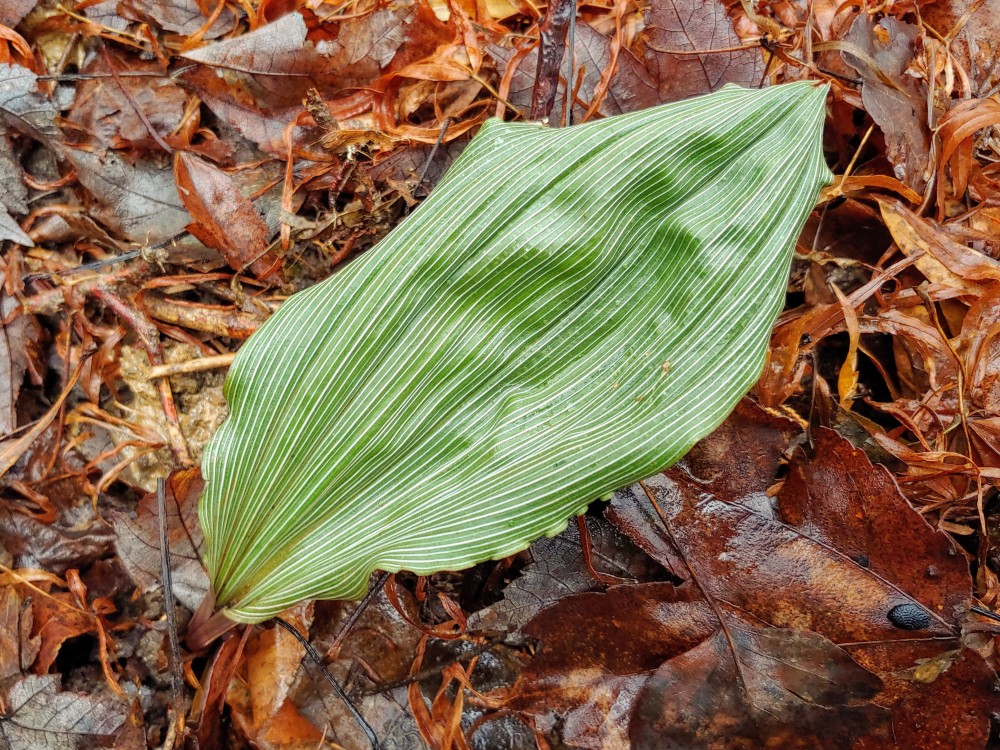A single leaf identifies each of three Putty root orchids (Aplectrum hyemale, below) successfully transplanted. I suspect this has required no particular expertise, though I attempted as much as is possible to duplicate conditions of a local forest where these are scattered about. The leaf, only one per orchid, will persist through winter, but fade long before the small flowering stalk appears in late spring. 
Little encouragement is required, of course, but this has inspired purchase of a few dozen more, as well as a dozen Rattlesnake plantain orchids (Goodyera pubescens) from a native plant supplier. I will figure spots for them upon delivery, which will be a bit challenging to find places where the small flowers can be seen.
On this drizzly, dark morning, the last day of the calendar year, there is no better reason to celebrate, though there is optimism that the coming year cannot be as wet as the one that is ending. Rain is very much appreciated, but enough is enough. No doubt, after a yearly increase of almost thirty inches, local gardeners will be whining about drought if any spell of dry weather extends more than a few weeks. I will be overjoyed to walk into the lower third of the garden without worrying that boots will be sucked off my feet in the muck.
Temperatures in recent weeks have been mild, with a day or two rising to sixty degrees, but mostly hovering around fifty (Fahrenheit). Mahonias and camellias continue to flower without severe cold, but hellebores with fat buds have made little progress in the relative warmth, and are not likely to bloom for weeks.

Flowering of hybrid daphnes (Daphne x transatlantica, above) ended several weeks ago, when overnight temperatures regularly dropped into the low twenties. But, buds tease of imminent blooms that are not likely unless our winter becomes unusually mild.
Happy New Year’s Eve to you and your family Dave! Here’s hoping you get less rain in the New Year and all your dreams for the garden come true in 2019….Thank you for the wonderful posts all year long! 😀
I’m happy that days are getting longer. Today I saw the first daffodils breaking through leaf litter. Soon, witch hazels will begin flowering, that sets off the countdown until spring.
Where’d you get the putty root from?
I’ve purchased a number of trilliums, false Solomon’s Seals, and ferns from Bluffview Nursery in middle Tennessee, an area I’ve visited annually for nearly forty years. A patch of Pachysandra procumbens is gaining a foothold, started from root segments purchased from Bluffview. Prices are inexpensive because small sections of root or rhizomes are shipped rather than larger plants. So far, everything I’ve had delivered have been plump roots or bulbs, though many are ephemerals that should not appear until this spring.
That daphne looks like a variegated azalea with honeysuckle flowers. I don’t know that one.
Daphne x transatlantic hybrids are cold hardy to zone 5, and flower from March into November. Not out of the ordinary for your area, but a treasure here. For some reason, I rarely see the variegated azaleas anymore. ‘Silver Sword’ was common thirty years ago.
All of those cool daphne are uncommon here. Even when we grew Daphne odorata ‘Variegata’, it was not very popular. I did not enjoy growing it much because, like the helebores, it looked so bad in the can. Yet, those who wanted it REALLY wanted it, and bought even the ugliest of plants. They did better in the landscape of course. We eventually discontinued them. Other growers provide a few more daphne that I had not seen years ago, but none are common. There are so many plants that should be more popular here than they are. Daphne is not good for all the regions of course, but does well in a certain band near the coast, set back enough from the coast where it gets warm and cool enough, but not so far inland that the weather is arid. It did well for us in Scott’s Valley, and an associate grew it quite well in Los Gatos (in town), which sort of surprised me.
We never grew even a single variegated azalea. We have a few stock plants of a few cultivars, but never got them into production. That fad faded out before we got started with them. We did not have them thirty years ago, but there was a short time within the last ten years or so when a few cultivars showed up in big box stores. I don’t know whey they were never popular. There was another with dark bronzed foliage that was quite weak. Although I do not trust modern cultivars, I think that older variegated cultivars would be worth growing if only there were a market for them. We find some of the oddest things to be marketable, while other things that should be more popular are not. When we grew the old fashioned ‘Purity’ camellia that was so popular in the 1960s, we could not grow them fast enough, and we continue to grow them. If they are so popular, why had they been so unavailable? When I grew citrus many years ago, I discontinued the classic ‘Marsh’ grapefruit because the pinks and reds were more popular (ick). Also, we sold as many ‘Buddha’s Hand’ citron trees as we can grow, even though no one ever told me what they are good for.